Read the Following Selection
Read the following selection, or click on the play button below to listen aloud.
The Great Lakes
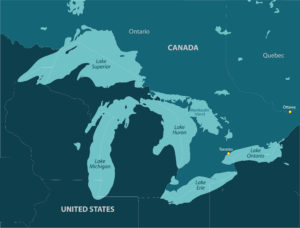
Map of the great lakes
No wonder these lakes in northeastern North America have received the name the Great Lakes. They are the largest group of freshwater lakes on Earth!
The Five Lakes
The five great lakes are located along the border between Canada and the United States. The lakes border on the province of Ontario, as well as on the American states of Illinois, Indiana, Minnesota, Michigan, New York, Ohio, Pennsylvania, and Wisconsin.
It is easy to remember the names of all five lakes. Just remember the word HOMES and it will remind you of the first letter in each of the names of the lakes: Huron, Ontario, Michigan, Erie, Superior.
Great Water, Shining Water

Lake Superior
The largest Great Lake is Lake Superior. It is the largest inland lake anywhere on Earth. Its name comes from the fact that it lies above, or superior to, the other Great Lakes. Indigenous Peoples called it Gitchigumi (pronounced Git-chee-goo-mee), which means “great lake.”

Lake Michigan
Lake Michigan lies entirely within the United States and is the world’s largest lake that is completely within one country. The lake’s name comes from the Indigenous word mishigami (pronounced mih-shi-ga-mee), which means “great water.”
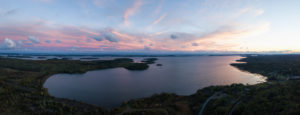
Lake Huron
Lake Huron was named by French explorers for the Huron Indigenous Peoples who lived in the area.
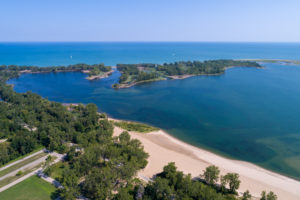
Lake Erie
A neighbouring Indigenous group also gave its name to Lake Erie.
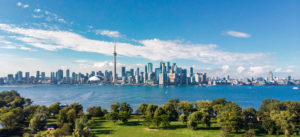
Toronto skyline on Lake Ontario
Lake Ontario gets its name from an Indigenous word that means “shining water.”
Between the Lakes

Niagara Falls
Between Lake Huron and Lake Erie is Lake St. Clair. It is so much smaller than the lakes around it that it is not considered one of the Great Lakes. Between Lake Erie and Lake Ontario is Niagara Falls, one of North America’s largest waterfalls.
Ships moving grain and other supplies from Canada’s prairies to countries in Europe are loaded in Thunder Bay, up on Lake Superior. They travel across Lake Superior, Lake Huron, and Lake Erie, but they have to bypass Niagara Falls by sailing through the Welland Canal. They finish their trip by sailing the length of Lake Ontario, then down the St. Lawrence River to the Atlantic Ocean.
Stormy Lakes
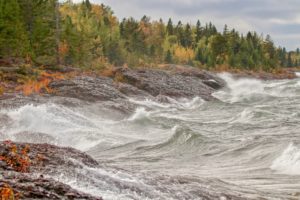
Picture of stormy weather on Lake Superior
Because the Great Lakes are so large, they are known for their rolling waves, blustery winds, and strong currents. Storms on these waters can be very dangerous. In the fall, bad weather can blow up suddenly. There are also hidden reefs in the Great Lakes that can wreck a ship.
Hundreds of ocean-going vessels have been shipwrecked in the Great Lakes. Most of them lie deep below the dark waters of Lake Huron, where the eastbound and westbound shipping lanes cross. There is also an area farther up in Lake Superior that has become known as the “Graveyard of the Great Lakes.”
Now, show what you know!
Complete some questions about the reading selection by clicking “Begin Questions” below.









